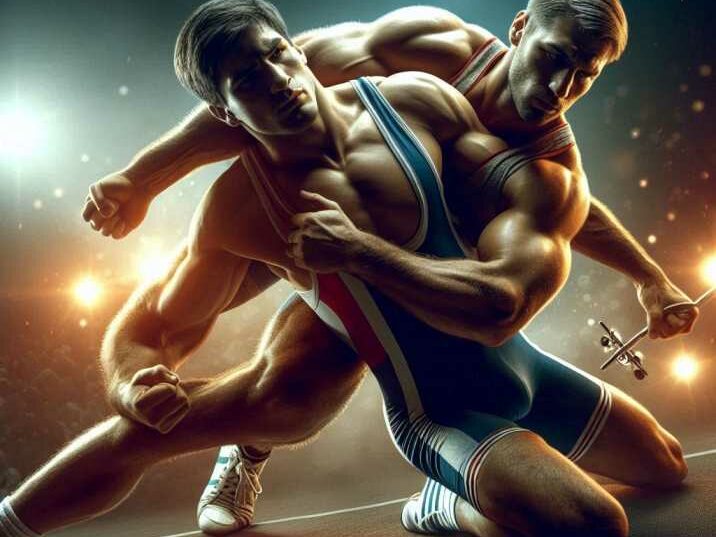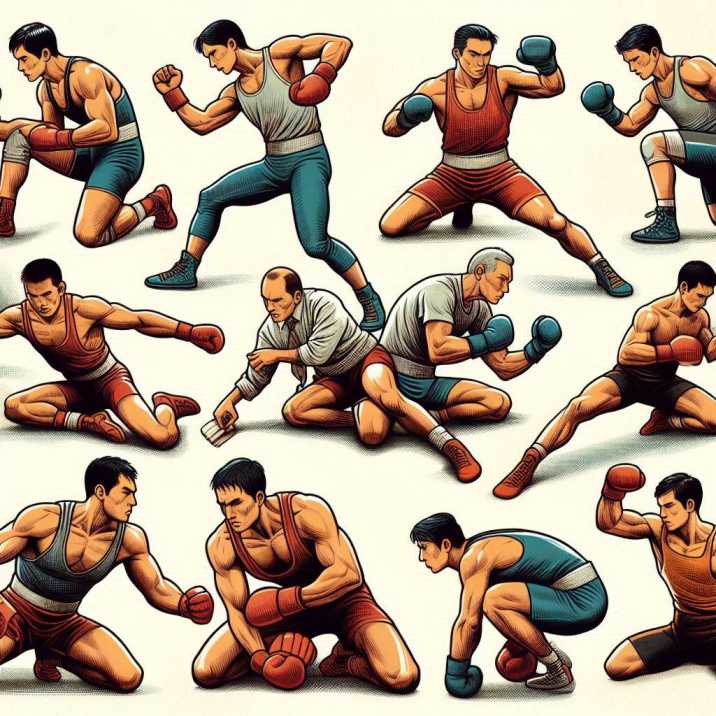Introduction
Table of Contents
Wrestling and boxing martial arts are two of the most prominent and historical forms of combat sports. From ancient civilizations to contemporary arenas, these disciplines have evolved, captivating audiences and shaping athletes worldwide. In this comprehensive guide, we will delve into the fascinating worlds of wrestling and boxing martial arts, exploring their origins, techniques, benefits, and much more.

Wrestling and Boxing Martial Arts: An Overview
Wrestling and Boxing Martial Arts: A Historical Perspective
Wrestling and boxing martial arts have deep roots in human history. Wrestling, one of the oldest sports, dates back to ancient Greece, where it was a crucial part of the Olympic Games. Boxing, on the other hand, has origins in ancient Egypt and Mesopotamia, where early forms of the sport were practiced with bare knuckles.
Wrestling: Ancient Traditions and Modern Evolution
Wrestling has been depicted in ancient cave paintings, showing its significance in early human societies. It was formalized in the Olympic Games of ancient Greece, making it a prestigious sport. Modern wrestling has evolved into various styles, including Greco-Roman and freestyle, each with unique rules and techniques.
Greco-Roman Wrestling
Greco-Roman wrestling focuses on upper body strength and techniques. It prohibits holds below the waist, making throws and lifts crucial components of the sport. This style emphasizes power and control, requiring athletes to master leverage and positioning.
Freestyle Wrestling
Freestyle wrestling allows the use of legs in both offense and defense, providing a broader range of techniques compared to Greco-Roman. Wrestlers can execute takedowns and holds using any part of the body, making it a more dynamic and versatile style.
Boxing: From Bare Knuckles to the Ring
Boxing’s history is equally rich, with evidence of early matches in ancient civilizations. The sport gained popularity in England in the 17th century, leading to the establishment of rules and the introduction of gloves. Today, boxing is a globally recognized sport with major events like the World Championships and the Olympic Games.
Early Boxing Rules
In the 17th century, boxing was often a brutal sport with few rules. Matches continued until one fighter was unable to continue. The introduction of the London Prize Ring Rules in the 18th century established the first set of formal rules, including the use of gloves.
Modern Boxing Regulations
Modern boxing follows the Marquess of Queensberry Rules, which were established in 1867. These rules introduced timed rounds, the ten-count for knockdowns, and standardized gloves, significantly reducing the sport’s brutality and making it more structured and competitive.
Wrestling and Boxing Martial Arts: Techniques and Training
Wrestling Techniques: Mastering the Grapple
Wrestling involves a combination of grappling techniques, including takedowns, throws, and holds. Wrestlers must develop strength, agility, and technique to overpower their opponents. Training typically includes drills to improve stamina, flexibility, and muscle endurance.
Common Wrestling Techniques
- Single Leg Takedown: A move where the wrestler grabs one of the opponent’s legs and pulls it to disrupt their balance.
- Double Leg Takedown: Involves grabbing both legs of the opponent to lift and drive them to the mat.
- Suplex: A high-impact move where the wrestler lifts the opponent and throws them backward onto the mat.
- Pin: Holding the opponent’s shoulders on the mat for a set period to win the match.
Boxing Techniques: The Art of Striking
Boxing focuses on striking techniques using fists, incorporating jabs, hooks, uppercuts, and crosses. Boxers must develop quick reflexes, hand-eye coordination, and defensive skills. Training involves shadowboxing, heavy bag work, and sparring sessions to hone these skills.
Key Boxing Techniques
- Jab: A quick, straight punch that is essential for setting up other strikes and maintaining distance.
- Hook: A powerful punch delivered in a semi-circular motion aimed at the side of the opponent’s head or body.
- Uppercut: An upward punch targeting the opponent’s chin, often used in close-range fighting.
- Cross: A straight punch thrown with the rear hand, crossing the body to deliver significant power.

Benefits of Wrestling and Boxing Martial Arts
Physical Fitness and Conditioning
Both wrestling and boxing provide excellent physical conditioning, enhancing cardiovascular health, muscle strength, and endurance. These sports require rigorous training, which translates to improved overall fitness.
Cardiovascular Endurance
Engaging in wrestling and boxing increases heart rate, improving cardiovascular endurance. Regular training sessions help enhance stamina and reduce the risk of heart-related conditions.
Muscle Strength
Wrestling builds overall body strength, particularly in the core, legs, and upper body. Boxing, on the other hand, develops upper body strength, especially in the arms, shoulders, and chest.
Self-Defense Skills
Learning wrestling and boxing equips individuals with effective self-defense techniques. Wrestlers can use their grappling skills to subdue opponents, while boxers can defend themselves with powerful strikes.
Wrestling for Self-Defense
Wrestling teaches control and leverage, allowing individuals to neutralize threats without causing severe harm. Techniques such as holds and pins are useful in self-defense situations to immobilize an attacker.
Boxing for Self-Defense
Boxing enhances striking power and speed, making it effective for self-defense. Boxers learn to deliver quick, powerful punches that can incapacitate an attacker and create an opportunity to escape.
Mental Toughness and Discipline
Engaging in wrestling and boxing fosters mental toughness, resilience, and discipline. Athletes must stay focused, strategic, and determined, qualities that benefit them both in and out of the ring.
Psychological Benefits
Both sports demand mental fortitude, teaching athletes to handle stress, remain calm under pressure, and recover from setbacks. These psychological skills are valuable in everyday life, promoting better coping mechanisms and resilience.
Famous Wrestlers and Boxers
Wrestling Legends: Icons of the Mat
Wrestling has produced numerous legendary athletes, such as Kurt Angle, a multi-time Olympic and World Champion, and Dan Gable, an iconic figure in American wrestling. These athletes have inspired generations with their dedication and achievements.
Kurt Angle
Kurt Angle is celebrated for his extraordinary achievements in both amateur and professional wrestling. He won a gold medal in freestyle wrestling at the 1996 Olympics and later became a prominent figure in professional wrestling with WWE.
Dan Gable
Dan Gable’s dominance in wrestling is unmatched. He won gold at the 1972 Olympics without conceding a single point and later became one of the most successful coaches in college wrestling history, leading the Iowa Hawkeyes to numerous championships.
Boxing Greats: Heroes of the Ring
Boxing has seen its share of legendary figures, including Muhammad Ali, known for his skill and charisma, and Mike Tyson, famous for his knockout power. These boxers have left an indelible mark on the sport and continue to inspire aspiring fighters.
Muhammad Ali
Muhammad Ali, often referred to as “The Greatest,” revolutionized boxing with his unparalleled skill and showmanship. His epic battles and outspoken personality made him a global icon, transcending the sport.
Mike Tyson
Mike Tyson, known as “Iron Mike,” became the youngest heavyweight champion in history at age 20. His ferocious style and knockout power captivated fans and made him one of the most feared boxers of all time.
Major Events in Wrestling and Boxing Martial Arts
Wrestling Competitions: Showcasing Strength and Skill
Wrestling is featured prominently in the Olympic Games, with events for various weight classes and styles. The World Wrestling Championships and NCAA Wrestling Championships are other major events that draw top talent from around the globe.
Olympic Wrestling
The Olympics showcase both Greco-Roman and freestyle wrestling, attracting the world’s best athletes. Winning an Olympic medal is considered the pinnacle of achievement in wrestling.
World Wrestling Championships
This annual event determines the world champions in various weight classes and styles. It is one of the most prestigious tournaments, second only to the Olympics.
Boxing Matches: The Pinnacle of Combat Sports
Boxing’s major events include the World Boxing Championships and high-profile professional bouts, often headlined by champions like Floyd Mayweather and Manny Pacquiao. These events attract massive audiences and generate significant media attention.
World Boxing Championships
The World Boxing Championships, organized by AIBA, crown the world’s best amateur boxers. This tournament is crucial for amateur boxers aiming to compete in the Olympics.
Professional Boxing Bouts
High-profile professional bouts, such as title fights and pay-per-view events, draw millions of viewers worldwide. These matches often feature the sport’s biggest stars and generate significant revenue.
Training Requirements and Equipment
Preparing for Wrestling: Strength and Technique
Wrestling training involves a mix of strength conditioning, technical drills, and sparring. Wrestlers need specific equipment, including singlets, headgear, and wrestling shoes, to train and compete effectively.
Essential Wrestling Equipment
- Singlet: A tight-fitting uniform that allows freedom of movement and prevents opponents from grabbing loose clothing.
- Headgear: Protects the ears from injury and reduces the risk of cauliflower ear.
- Wrestling Shoes: Lightweight and flexible shoes designed to provide traction on the mat.
Boxing Training: Speed and Power
Boxing training focuses on developing speed, power, and technique. Boxers use equipment like gloves, hand wraps, punching bags, and mouthguards. Regular sparring sessions are crucial for honing skills and preparing for competition.
Essential Boxing Equipment
- Boxing Gloves: Protect the hands and reduce the impact of punches.
- Hand Wraps: Provide additional support and protection for the wrists and knuckles.
- Punching Bags: Used for practicing punches and building strength and endurance.
- Mouthguards: Protect the teeth and reduce the risk of injury during sparring.
Health Benefits of Wrestling and Boxing Martial Arts
Cardiovascular Health and Fitness
Both wrestling and boxing provide intense cardiovascular workouts, improving heart health and stamina. The high-intensity nature of these sports helps burn calories and maintain a healthy weight.
Cardio Conditioning
Training sessions in wrestling and boxing involve continuous movement, which increases heart rate and improves cardiovascular efficiency. This helps in lowering blood pressure and reducing the risk of heart diseases.
Muscle Strength and Coordination
Wrestling and boxing enhance muscle strength and coordination. Wrestlers develop strong, flexible muscles through grappling, while boxers build upper body strength and agility through striking exercises.
Improved Coordination
Both sports require precise movements and timing, which enhance hand-eye coordination and overall body coordination. This improved coordination benefits daily activities and reduces the risk of injuries.
Common Injuries and Prevention
Wrestling Injuries: Managing the Risks
Wrestling can lead to joint injuries, sprains, and strains due to the physical nature of the sport. Proper warm-up routines, strength training, and adherence to safety guidelines can help mitigate these risks.
Preventive Measures
- Warm-Up: Always start with a proper warm-up to prepare muscles and joints for the physical exertion.
- Strength Training: Build strength in key muscle groups to support joints and prevent injuries.
- Safety Gear: Use protective gear like headgear and knee pads to reduce the risk of injuries.
Boxing Injuries: Staying Safe in the Ring
Boxing carries risks of concussions, cuts, and bruises. Using proper protective gear, following training protocols, and focusing on defensive techniques are essential for minimizing injury risks.
Preventive Measures
- Protective Gear: Wear headgear during sparring to protect against head injuries.
- Technique Training: Learn and practice proper techniques to avoid unnecessary injuries.
- Rest and Recovery: Allow adequate time for rest and recovery to prevent overuse injuries.
Cultural Impact of Wrestling and Boxing Martial Arts
Wrestling and Boxing in Popular Culture
Wrestling and boxing have significantly influenced popular culture, inspiring movies, TV shows, and literature. Films like “Rocky” and “The Wrestler” showcase the grit and determination of fighters, resonating with audiences worldwide.
Influence on Media
Movies and TV shows featuring wrestling and boxing have brought these sports to mainstream audiences. Characters like Rocky Balboa and Hulk Hogan have become cultural icons, representing the resilience and strength associated with these sports.
Impact on Society
Wrestling and boxing have also influenced societal attitudes towards fitness, discipline, and perseverance. They have inspired individuals to pursue physical fitness and personal growth through martial arts training.
Table of Information
| Topic | Details |
|---|---|
| Origins | Wrestling: Ancient Greece, Boxing: Ancient Egypt |
| Techniques | Wrestling: Grappling, Boxing: Striking |
| Key Benefits | Fitness, Self-Defense, Mental Toughness |
| Famous Athletes | Wrestling: Kurt Angle, Boxing: Muhammad Ali |
| Major Events | Wrestling: Olympics, Boxing: World Championships |
| Training Requirements | Physical Conditioning, Technical Skills |
| Equipment Needed | Wrestling: Singlet, Boxing: Gloves |
| Health Benefits | Cardiovascular Health, Strength, Coordination |
| Common Injuries | Wrestling: Joint Injuries, Boxing: Concussions |
| Cultural Impact | Movies, TV, Popular Culture |
Frequently Asked Questions (FAQs)
1. What are the primary differences between wrestling and boxing?
Wrestling focuses on grappling techniques, while boxing emphasizes striking with fists. Both require different training methods and skills.
2. Can I practice wrestling and boxing simultaneously?
Yes, many athletes train in multiple martial arts to develop a well-rounded skill set. However, managing time and training intensity is crucial to avoid overtraining.
3. How long does it take to become proficient in wrestling or boxing?
Proficiency depends on individual dedication, training frequency, and natural ability. Generally, consistent training for several years is needed to reach a high skill level.
4. Are wrestling and boxing suitable for all ages?
Both sports can be practiced by people of all ages, with appropriate modifications for safety. Youth programs and adult classes cater to different age groups and skill levels.
5. What should I look for in a wrestling or boxing gym?
Look for qualified coaches, safe training environments, and supportive communities. Check for proper equipment and facilities to ensure a comprehensive training experience.


